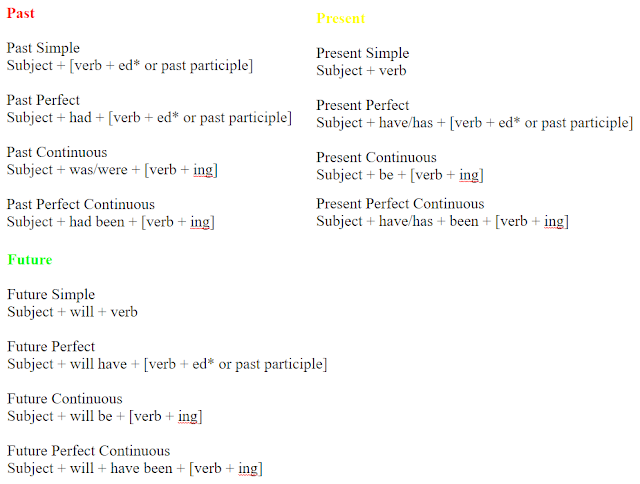Hello, I'm Laura! My nickname is Lolo. I'm a Canadian EFL teacher who loves to travel! Welcome to Lolo on the Gogo! Please feel free to email me at lolotravelgogo@gmail.com or comment below if you have any questions! Enjoy the lesson.
There are 12 English tenses. The tenses fall into three time categories: past, present and future. We can also categorize the tenses into four specific types: simple, perfect, continuous and perfect continuous.
The tenses are as follows: past simple, past perfect, past continuous, past perfect continuous, present simple, present perfect, present continuous, present perfect continuous, future simple, future perfect, future continuous, future perfect continuous.
Alternatively, we can organize the list as follows: past simple, present simple, future simple, past simple, past perfect, past continuous, past perfect continuous, future simple, future perfect, future continuous, future perfect continuous.
When we study something complicated, it often helps to try organizing the data in different ways. I hope this post will help you to compare and contrast and to better visualize the similarities and differences between the twelve tenses.
Please enjoy the following presentation of the grammatical formulas for each English tense. The first list is colour-coded, the second list is plain and the third list reorganizes the tenses into the four categories simple, perfect, continuous and perfect continuous.
In the colour-coded list, past tenses are labelled various shades of red, present tense is yellow and future tense is green. I chose these colours because of the symbolism of a stoplight, where red means stop, yellow means slow and green means go. I thought about making the present tense green, but didn't want to mix up the order of the colours, and also wanted past tense to be red, signalling that it speaks to finished actions.
Past
Past Simple
Subject + [verb + ed* or past participle]
Past Perfect
Subject + had + [verb + ed* or past participle]
Past Continuous
Subject + was/were + [verb + ing]
Past Perfect Continuous
Subject + had been + [verb + ing]
Present
Present Simple
Subject + verb
Present Perfect
Subject + have/has + [verb + ed* or past participle]
Present Continuous
Subject + be + [verb + ing]
Present Perfect Continuous
Subject + have/has + been + [verb + ing]
Future
Future Simple
Subject + will + verb
Future Perfect
Subject + will have + [verb + ed* or past participle]
Future Continuous
Subject + will be + [verb + ing]
Future Perfect Continuous
Subject + will + have been + [verb + ing]
*The past participle is formed by the verb + ed in most cases, except irregular verbs
* * *
Past
Past Simple
Subject + [verb + ed* or past participle]
Subject + [verb + ed* or past participle]
Past Perfect
Subject + had + [verb + ed* or past participle]
Subject + had + [verb + ed* or past participle]
Past Continuous
Subject + was/were + [verb + ing]
Subject + was/were + [verb + ing]
Past Perfect Continuous
Subject + had been + [verb + ing]
Present
Present Simple
Subject + verb
Present Perfect
Subject + have/has + [verb + ed* or past participle]
Present Perfect
Subject + have/has + [verb + ed* or past participle]
Present Continuous
Subject + be + [verb + ing]
Subject + be + [verb + ing]
Present Perfect Continuous
Subject + have/has + been + [verb + ing]
Future
Future Simple
Subject + will + verb
Future Perfect
Subject + will have + [verb + ed* or past participle]
Future Continuous
Subject + will have + [verb + ed* or past participle]
Future Continuous
Subject + will be + [verb + ing]
Future Perfect Continuous
Subject + will + have been + [verb + ing]
Future Perfect Continuous
Subject + will + have been + [verb + ing]
*The past participle is formed by the verb + ed in most cases, except irregular verbs
* * *
Simple
Past Simple
Subject + [verb + ed* or past participle]
Perfect
Present Simple
Subject + verb
Future Simple
Subject + will + verb
Future Simple
Subject + will + verb
Perfect
Past Perfect
Subject + had + [verb + ed* or past participle]
Present Perfect
Subject + have/has + [verb + ed* or past participle]
Future Perfect
Subject + will have + [verb + ed* or past participle]
Continuous
Subject + had + [verb + ed* or past participle]
Present Perfect
Subject + have/has + [verb + ed* or past participle]
Future Perfect
Subject + will have + [verb + ed* or past participle]
Continuous
Past Continuous
Subject + was/were + [verb + ing]
Present Continuous
Subject + be + [verb + ing]
Future Continuous
Subject + was/were + [verb + ing]
Present Continuous
Subject + be + [verb + ing]
Future Continuous
Subject + will be + [verb + ing]
Perfect Continuous
Past Perfect Continuous
Present Perfect Continuous
Subject + have/has + been + [verb + ing]
Future Perfect Continuous
Subject + will + have been + [verb + ing]
*The past participle is formed by the verb + ed in most cases, except irregular verbs
* * *
See Also:






Thanks for the incredibly helpful article . You explained this perfectly and I loved a lot of your points. Great everything! Lots of useful resources and links on types of sentences . I am definitely going to add that into my next must read blog and shout you out.
ReplyDeleteThank you very much! That's lovely! ❤
DeleteThanks for your comment! 😊
ReplyDelete